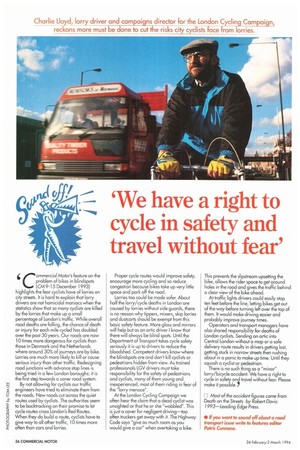'We have a right to cycle in safety and travel without fear'
Page 38

If you've noticed an error in this article please click here to report it so we can fix it.
C ommercial Motor's feature on the
problem of bikes in blindspots (CM 9-15 December 1993) highlights the fear cyclists have of lorries on city streets. It is hard to explain that lorry drivers are not homicidal maniacs when the statistics show that so many cyclists are killed by the lorries that make up a small percentage of London's traffic. While overall road deaths are falling, the chance of death or injury for each mile cycled has doubled over the past 30 years. Our roads are now 10 times more dangerous for cyclists than those in Denmark and the Netherlands where around 30% of journeys are by bike. Lorries are much more likely to kill or cause serious injury than other traffic. Redesigning road junctions with advance stop lines is being tried in a few London boroughs: it is the first step towards a saner road system. By not allowing for cyclists our traffic engineers have fried to eliminate them from the roads. New roads cut across the quiet routes used by cyclists. The authorities seem to be backtracking on their promise to let cycle routes cross London's Red Routes. When they do build a route, cyclists have to give way to all other traffic, 10 times more often than cars and lorries. Proper cycle routes would improve safety, encourage more cycling and so reduce congestion because bikes take up very little space and park off the road. Lorries too could be made safer. About half the lorry/cycle deaths in London are caused by lorries without side guards, there is no reason why tippers, mixers, skip lorries and dustcarts should be exempt from this basic safety feature. More glass and mirrors will help but as an artic driver I know that there will always be blind spots. Until the Department of Transport takes cycle safely seriously it is up to drivers to reduce the bloodshed. Competent drivers know where the blindspots are and don't kill cyclists or pedestrians hidden from view. As trained professionals LGV drivers must take responsibility for the safety of pedestrians and cyclists, many of them young and inexperienced, most of them riding in fear of the "lorry menace". At the London Cycling Campaign we often hear the claim that a dead cyclist was unsighted or that he or she "wobbled". This is just a cover for negligent driving—too often truckers get away with it. The Highway Code says "give as much room as you would give a car" when overtaking a bike. This prevents the slipstream upsetting the bike, allows the rider space to get around holes in the road and gives the traffic behind a clear view of the bike ahead.
At traffic lights drivers could easily stop ten feet before the line, letting bikes get out of the way before turning left over the top of them. It would make driving easier and probably improve journey times.
Operators and transport managers have also shared responsibility for deaths of London cyclists. Sending an artic into Central London without a map or a safe delivery route results in drivers getting lost, getting stuck in narrow streets then rushing about in a panic to make up time. Until they squash a cyclist or pedestrian. There is no such thing as a "minor" lorry/bicycle accident. We have a right to cycle in safety and travel without fear. Please make it possible./
Fl Most of the accident figures come from Death on the Streets by Robert Davis: 1993—Leading Edge Press.




















































































